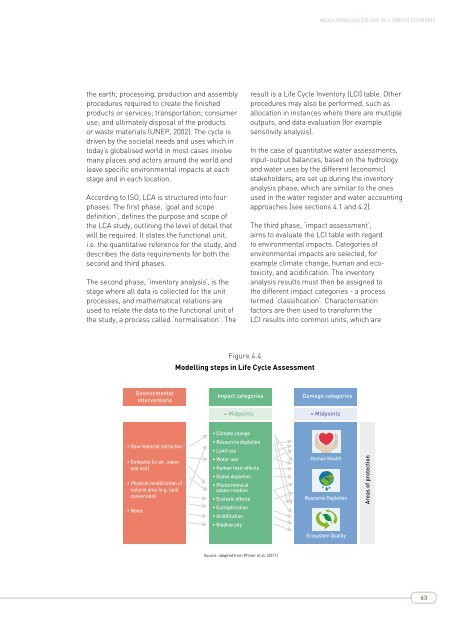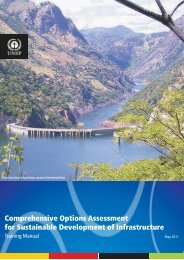MEASURING WATER USE IN A GREEN ECONOMY - UNEP
MEASURING WATER USE IN A GREEN ECONOMY - UNEP
MEASURING WATER USE IN A GREEN ECONOMY - UNEP
You also want an ePaper? Increase the reach of your titles
YUMPU automatically turns print PDFs into web optimized ePapers that Google loves.
Measuring water use in a green economy<br />
the earth; processing, production and assembly<br />
procedures required to create the finished<br />
products or services; transportation; consumer<br />
use; and ultimately disposal of the products<br />
or waste materials (<strong>UNEP</strong>, 2002). The cycle is<br />
driven by the societal needs and uses which in<br />
today’s globalised world in most cases involve<br />
many places and actors around the world and<br />
leave specific environmental impacts at each<br />
stage and in each location.<br />
According to ISO, LCA is structured into four<br />
phases. The first phase, ‘goal and scope<br />
definition’, defines the purpose and scope of<br />
the LCA study, outlining the level of detail that<br />
will be required. It states the functional unit,<br />
i.e. the quantitative reference for the study, and<br />
describes the data requirements for both the<br />
second and third phases.<br />
The second phase, ‘inventory analysis’, is the<br />
stage where all data is collected for the unit<br />
processes, and mathematical relations are<br />
used to relate the data to the functional unit of<br />
the study, a process called ‘normalisation’. The<br />
result is a Life Cycle Inventory (LCI) table. Other<br />
procedures may also be performed, such as<br />
allocation in instances where there are multiple<br />
outputs, and data evaluation (for example<br />
sensitivity analysis).<br />
In the case of quantitative water assessments,<br />
input-output balances, based on the hydrology<br />
and water uses by the different (economic)<br />
stakeholders, are set up during the inventory<br />
analysis phase, which are similar to the ones<br />
used in the water register and water accounting<br />
approaches (see sections 4.1 and 4.2).<br />
The third phase, ‘impact assessment’,<br />
aims to evaluate the LCI table with regard<br />
to environmental impacts. Categories of<br />
environmental impacts are selected, for<br />
example climate change, human and ecotoxicity,<br />
and acidification. The inventory<br />
analysis results must then be assigned to<br />
the different impact categories - a process<br />
termed ‘classification’. Characterisation<br />
factors are then used to transform the<br />
LCI results into common units, which are<br />
Figure 4.4<br />
Figure 4.4<br />
Modelling steps in Life Cycle Assessment<br />
Modelling steps in Life Cycle Assessment<br />
Environmental<br />
interventions<br />
Impact categories<br />
Damage categories<br />
= Midpoints = Midpoints<br />
• Climate change<br />
• Resourcve depletion<br />
• Land use<br />
• Water use<br />
• Human toxic effects<br />
• Ozone depletion<br />
• Photochemical<br />
ozone creation<br />
• Raw material extraction<br />
• Emission (in air, water<br />
and soil)<br />
• Physical modification of<br />
natural area (e.g. land<br />
conversion)<br />
• Noise<br />
• Ecotoxic effects<br />
• Eutrophication<br />
• Acidification<br />
• Biodiversity<br />
Human Health<br />
Resource Depletion<br />
Areas of protection<br />
Ecosystem Quality<br />
Source: adapted from Pfister et al. (2011)<br />
63

















